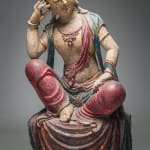Ming Wooden Polychromed Bodhisattva, 1368 CE - 1644 CE
Polychromed Wood
100.3 x 43.2 cm
39 1/2 x 17 in
39 1/2 x 17 in
AM.0162
Further images
Representation of the Bodhisattva of Mercy, known as Avalokiteshvara, or Guanyin in Chinese. Bodhisattvas were originally depicted as the Buddha’s attendants but increasingly came to be venerated in their own...
Representation of the Bodhisattva of Mercy, known as Avalokiteshvara, or Guanyin in Chinese. Bodhisattvas were originally depicted as the Buddha’s attendants but increasingly came to be venerated in their own right. Avalokiteshvara is identifiable by the small seated Buddha that appears in the Headdress. This figure was so popular in China that by the Tang era its image outnumbered those of the Buddha.
Although Buddhist texts do not specify the gender of bodhisattvas, the early examples tend to be male. From the end of the Song Dynasty (1279) this trend was reversed and by the Ming period such images are clearly feminine. In this sculpture Avalokiteshvara is seated on a pedestal covered with an elaborate gilded drapery which falls in concentric folds. The Head is slightly bent and supported by the right arm, with one of the exquisitely carved fingers resting lightly against the cheek. The upper body is bare except for a delicate necklace and celestial scarves. The lower body is covered by a waist length tunic and all the details of the costume are enlivened by the use of red, green and blue pigments.
This work belongs to a group of three bodhisattvas all in the Barakat collection. The overall impression is one of immense calm and meditation.- (AM.0162)
Although Buddhist texts do not specify the gender of bodhisattvas, the early examples tend to be male. From the end of the Song Dynasty (1279) this trend was reversed and by the Ming period such images are clearly feminine. In this sculpture Avalokiteshvara is seated on a pedestal covered with an elaborate gilded drapery which falls in concentric folds. The Head is slightly bent and supported by the right arm, with one of the exquisitely carved fingers resting lightly against the cheek. The upper body is bare except for a delicate necklace and celestial scarves. The lower body is covered by a waist length tunic and all the details of the costume are enlivened by the use of red, green and blue pigments.
This work belongs to a group of three bodhisattvas all in the Barakat collection. The overall impression is one of immense calm and meditation.- (AM.0162)











